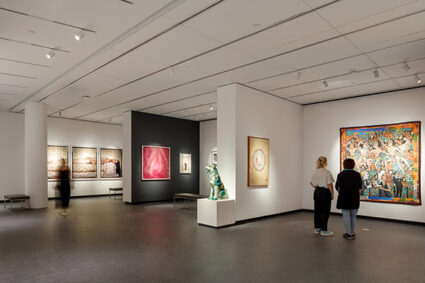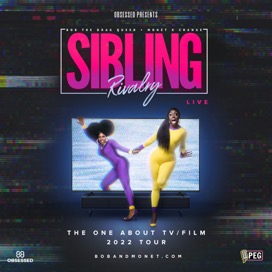
Wilhelmina Cole Holladay, who founded the National Museum of Women in the Arts (NMWA), the first and only museum solely dedicated to championing women through the arts, died on Saturday, March 6, 2021, at the age of 98 in Washington, D.C.
Against tremendous odds and with dedication, drive and a singular vision, Holladay created a museum to help alleviate the underrepresentation of women artists in museums and galleries worldwide.
“For nearly 40 years, Wilhelmina Holladay has been the guiding light of our museum,” said Director Susan Fisher Sterling. “Mrs. Holladay knew the power of art and the importance of women in art and in the world. Her foresight in recognizing women artists of the past and championing women artists of the present by creating a new museum was visionary—even revolutionary—for the time. Her actions signaled a major shift in our thinking about art and society, and it is her genius and purpose we carry forward with us today.”
“Wilhelmina, ‘Billie’ as she was known to her friends, believed deeply in philanthropy and volunteerism,” said Board Vice-Chair and daughter-in-law Winton Smoot Holladay. “Her leadership and generosity established the museum, and she worked tirelessly to create an important institution where women artists could fully participate in and shape the national and international cultural conversation. Her unwavering sense of purpose and her love of art enriched the lives of all who were privileged to work alongside her.”
Holladay’s interest in art by women began in the 1970s, when she and her husband Wallace traveled widely to visit museums and galleries. They were particularly drawn to a painting they saw in Vienna, a 1594 still life by Flemish artist Clara Peeters. They saw additional paintings by Peeters at the Prado in Madrid. When Holladay attempted to learn more about the artist, she could find no information on Peeters—or any other female artist—in the standard art history textbook, H. W. Janson’s History of Art. Astonished by this discovery, the Holladays began to search for work by other women artists.
By the 1980s, the Holladay collection had grown to approximately 500 works by 150 artists, from the Renaissance to contemporary times. In addition to artwork, the Holladays kept an archive of catalogues, books, photographs and biographical information on women artists. Nancy Hanks, then head of the National Endowment for the Arts, encouraged the Holladays to consider establishing a museum, and Holladay focused her considerable organizational and fundraising skills in this direction.
NMWA was incorporated in 1981, and for the next six years, Holladay opened her residence to the public for tours, traveled extensively to garner support for her idea, raised more than $20 million from public and private sources, purchased and renovated a historic building to house the collection and donated her personal collection and library to the museum. On April 7, 1987, Barbara Bush, wife of the then-Vice President, cut the ribbon to open the museum in a 1907 Renaissance revival landmark building located two blocks from the White House.
NMWA’s collection has grown to include more than 5,500 works by approximately 1,000 artists, such as Louise Bourgeois, Mary Cassatt, Judy Chicago, Frida Kahlo, Georgia O’Keeffe, Faith Ringgold and Élizabeth Louise Vigée-Lebrun. Special exhibitions have included premier solo showings of work by Camille Claudel (19th-century French), Remedios Varo (20th-century Mexican), Lavinia Fontana (16th-century Italian) and Carrie Mae Weems (contemporary American). The diversity of women’s artistic creativity has been showcased in exhibitions featuring treasures from the Hermitage, pottery by American Indians, theatrical creations by Julie Taymor, representations of the Virgin Mary in Western art, abstract art by black women artists and work by emerging artists in the museum’s signature Women to Watch series. These exhibitions have broadened the art historical canon to be more open and inclusive.
The museum is also a leader in online content and arts education, serving the local community through outreach to D.C. public and private charter schools as well as developing an arts education model for schools nationwide. NMWA’s Women, Arts and Social Change public program initiative offers a platform for speakers and attendees to advance ideas and solutions to society’s most pressing issues—especially those affecting women and girls—and inspires action in the arts and beyond. NMWA also publishes a triennial magazine, serves as a center for the performing and literary arts and maintains one of the foremost repositories of documents and materials on women artists.
In over 35 years, the museum’s budget has grown to $11 million, and the full-time staff numbers 50. NMWA members and donors, nearly 13,000 strong, come from all over the United States and 21 other countries. Its network of national and international committees has 25 outreach groups with more than 3,000 dedicated members throughout the United States and around the world, including Chile, France, Peru and the United Kingdom. The committees host regional programs and serve as ambassadors for the museum.
Holladay was born on Oct. 10, 1922, in Elmira, N.Y. She developed an early appreciation of art from her maternal grandmother. She earned a BA degree from Elmira College in 1944, studied art history at Cornell University and completed postgraduate work in art history at the University of Paris in 1953–54. During World War II, Holladay worked in Washington, D.C., where she met her husband, an officer in the United States Navy. She worked as social secretary to Madame Chiang Kai-Shek from 1945 to 1948, but after the birth of her son Wallace Jr., she dedicated herself to volunteer projects.
In addition to serving as the museum’s chair of the board, Holladay was active in many other ventures, serving on the boards of the National Women’s Economic Alliance, the Adams National Bank, the Corcoran Gallery of Art, the World Service Council of the YWCA, the American Academy in Rome, the United States Capitol Historical Society, the National Gallery of Art’s Collector’s Committee and the International Women’s Forum. In recognition of her service, Holladay received the National Medal of Arts as well as diplomatic orders from France and Norway. She also was regularly listed as one of the most powerful women in Washington, D.C, and received a lifetime achievement award from the District of Columbia. Among Holladay’s other awards for her service to women include induction into the National Women’s Hall of Fame, a lifetime achievement award from the Women’s Caucus for Art, the Women Who Make a Difference Award from the International Women’s Forum and the Distinguished Achievement Award from the National League of American Pen Women. She received honorary doctorate degrees from four colleges.
Holladay was predeceased by a son, Scott Cole Holladay and her husband, Wallace F. Holladay. Holladay is survived by a son and daughter-in-law, Wallace “Hap” Holladay Jr. and Winton Holladay, four grandchildren, Brook Holladay Peters (Brian), Fitz Holladay, Jessica Holladay Sterchi (Louis) and Addison Holladay (Eliza), and nine great-grandchildren.
A celebration of life will be announced at a future date. In lieu of flowers, the family requests contributions may be made to the National Museum of Women in the Arts.


